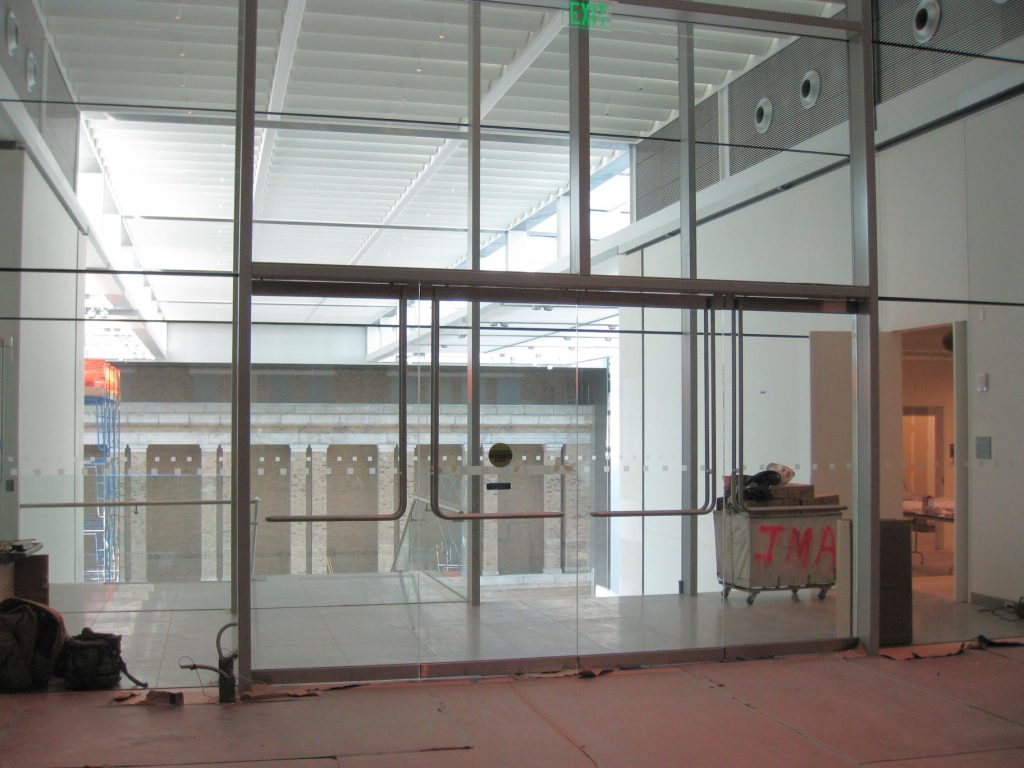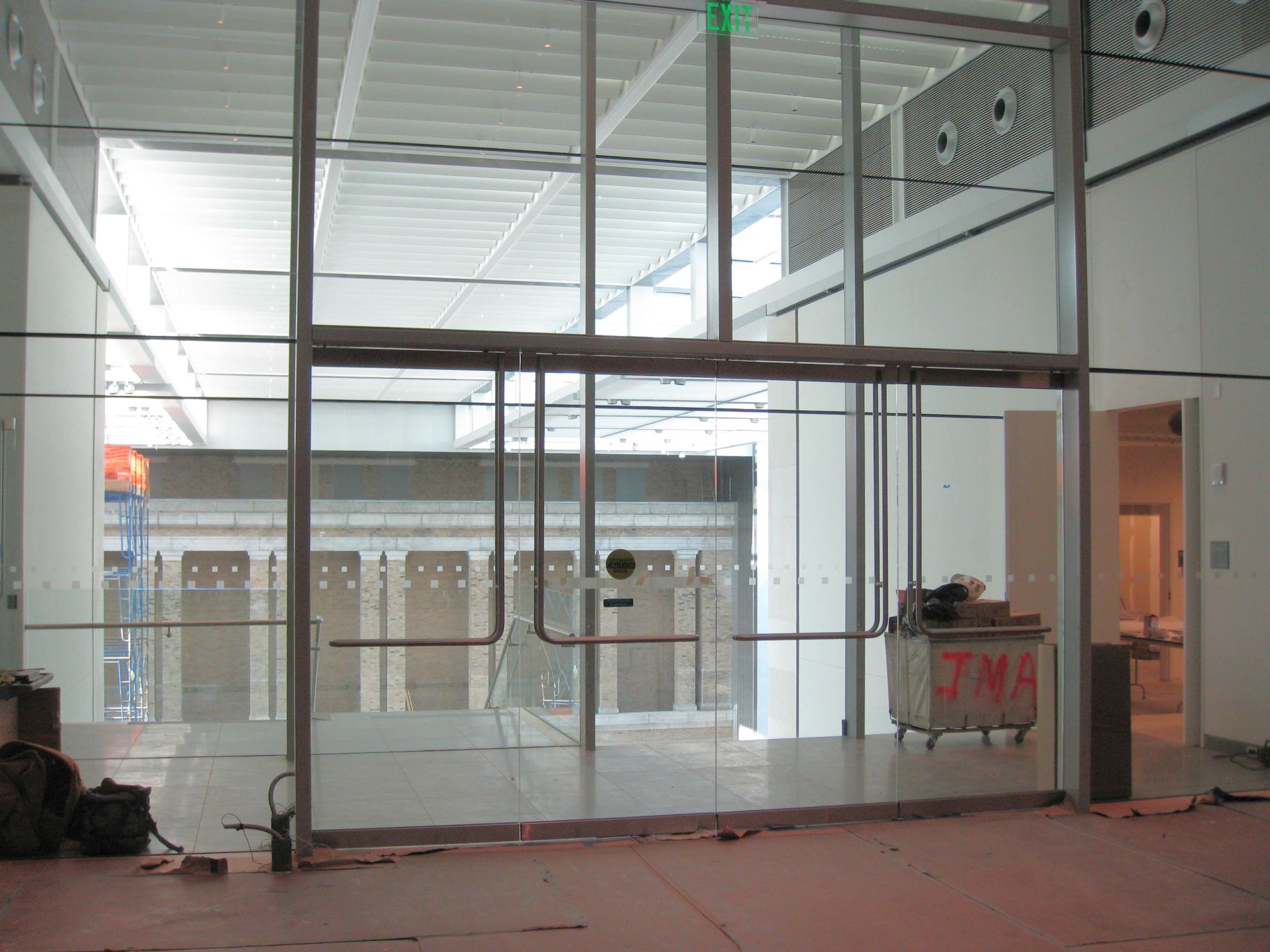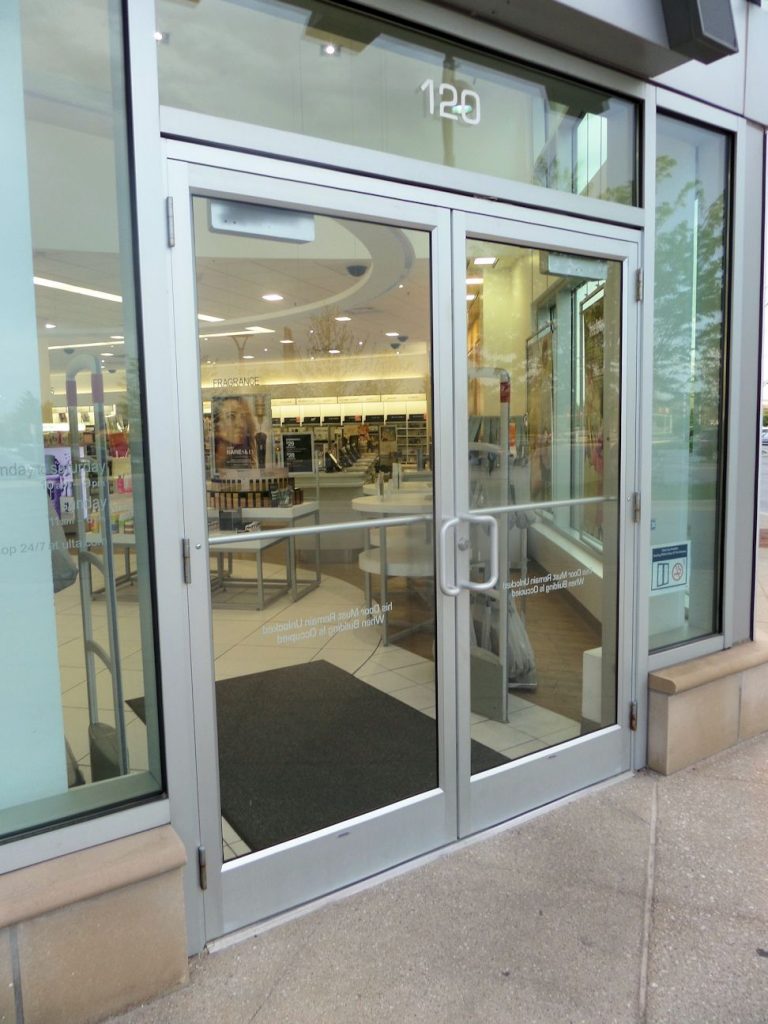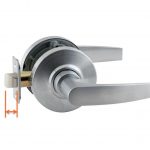Last Friday I posted a photo of an aluminum frame that had been prepped incorrectly for center pivots and an ASA strike. One of the comments brought up a good point…the mistake may have been caused in part by where/how the hardware was specified. On this particular project, maybe the way the hardware was specified caused the problem, maybe it didn’t, but regardless – specifying and supplying the aluminum door hardware and hardware for all-glass doors has always been a bone of contention in the door and hardware industry.
For a door hardware consultant, there are disadvantages to “taking ownership” of the hardware for aluminum and all-glass doors. There’s a fair amount of coordination required. Some of the hardware may be provided with the door and frame package. The doors or frames may have details of design or construction that will affect the hardware. There’s the question of who is going to provide the hardware, and who is responsible for the installation.
On the other hand, if the aluminum/glass door hardware is included in the hardware specification, it’s easier to maintain continuity between the hardware for all doors on the project – I’ve seen many buildings where hardware from one set of manufacturers was installed on the aluminum storefront doors, and different products were used on the hollow metal and wood doors. This makes maintenance more difficult because there are two sets of products and representatives to deal with. There’s also coordination required for the key system, and the aesthetic inconsistency between interior and exterior doors can be an issue for some buildings.
When I started as a door and hardware distributor in the late 80’s, it was very common for us to supply just the key cylinder, with the aluminum storefront company supplying everything else. Prior to that I worked for a distributor of aluminum doors, frames, and glazing, and we barely gave the hardware a second thought. We were focused on getting the framing and glass configuration just right so it would fit properly in the opening. Doors were either narrow-, medium-, or wide stile, and the aluminum door manufacturer would include the hinges or pivots, deadlock, deadlatch, or panic hardware, and a door closer. The weatherstrip and threshold came as part of the package. When I went to work for the door and hardware distributor, I thought doors were either left-hand or right-hand – I had no idea there were reverse-bevel doors. I know this has changed for some aluminum door companies, but many aluminum door submittals still include very little information about the hardware.
 Fast forward to my last few projects as a specwriter – all very complicated jobs like museums, courthouses, and a very high-security data center. On those projects, there were many doors with electrified hardware – both interior and exterior. The buildings were high-profile, where the architects were scrutinizing every detail. There were codes to consider…on several projects there were glass doors used in a smoke partition, which needed to latch upon fire alarm. Some all-glass doors with glass sidelights and transoms (no framing at all) required automatic operators. Most of the doors served Assembly occupancies and required panic hardware. After a lot of coordination between the aluminum/glass door suppliers, architects, end users, security consultants, and me (the hardware specifier), we had hardware specifications that jived with the doors, frames, security plans, functional needs, code requirements, and the hardware on the rest of the project. It wasn’t easy, but the up-front work helped avoid problems later on.
Fast forward to my last few projects as a specwriter – all very complicated jobs like museums, courthouses, and a very high-security data center. On those projects, there were many doors with electrified hardware – both interior and exterior. The buildings were high-profile, where the architects were scrutinizing every detail. There were codes to consider…on several projects there were glass doors used in a smoke partition, which needed to latch upon fire alarm. Some all-glass doors with glass sidelights and transoms (no framing at all) required automatic operators. Most of the doors served Assembly occupancies and required panic hardware. After a lot of coordination between the aluminum/glass door suppliers, architects, end users, security consultants, and me (the hardware specifier), we had hardware specifications that jived with the doors, frames, security plans, functional needs, code requirements, and the hardware on the rest of the project. It wasn’t easy, but the up-front work helped avoid problems later on.
If you’re involved in specifying, supplying, coordinating, or maintaining hardware for aluminum or glass doors, WWYD? Where should the hardware be specified and how do you ensure that all of the details are addressed in the design phase?
You need to login or register to bookmark/favorite this content.







All door hardware included in Section 08 71 00 – Door Hardware.
My door hardware specifiers (whether manufacturer-sponsored or fee-based) review my aluminum entrances section as part of their services. Their preferences vary somewhat – most specify all the hardware in 08 71 00 Door Hardware and indicate which components are entrance manufacturers’ standard. Occasionally the hardware is scheduled in the aluminum entrances section and has only a placeholder in the door hardware section. (“Set 10 – see Section 08 41 13…”) My architects and I rely heavily on the hardware specifier to coordinate the requirements, so we don’t try to dictate where the information appears.
All that up-front work you’re talking about is key. The bane of our existence on complex projects is the owner’s security consultant being engaged late or unwilling to participate until after the hardware is designed (the first time). If we could always get the security envelope and special security functions at the end of Design Development, we’d have plenty of time to resolve the tricky requirements. We ask, but we don’t always get.
The bane of MY existence was when the security consultant got there first and didn’t realize there were code-related issues with their plan. Then I had to be the bad guy and tell the design team what needed to change. One architect called me the “anti-fairy godmother”! :\
– Lori
Ha ha! Yes, security and code compliance are often clotheslining each other when one of them gets ahead of the other’s ideas. It’s never fun to be the bearer of bad news! What I wouldn’t give to get a dedicated hardware conference with all stakeholders on every project…
I would love to see your take on secure and compliant doors accessing second floor amenities balconies. (Speaking of aluminum doors with special hardware requirements…)
I’ll cover the balcony question in my next Decoded article!
– Lori
Awesome! Thanks!
I wonder if the dilemma of who is to provide the hardware varies geographically. In Eastern Iowa it seems as it is 50/50 whether the glazer or the door distributor will provide the hardware for the Aluminum Storefronts. It is also NEVER clearly specified who is to provide the hardware. Most of the time we just provide a voluntary alternate to the GC to include the Aluminum Hardware. We have been awarded work by going this route.
What Vivian said …
Door hardware belongs in the door hardware section, and then related sections — including electronic access control — need to reference the door hardware section. Door hardware consultants need to review the related sections as part of their service to ensure a well-coordinated project manual.
As a spec writer in the Southeast, it also seems to go both ways.
On the more complex projects with access controls, I always write in hardware for the aluminum storefront doors.
Does not matter to me who furnishes it as long as they furnish something comparable to what I have written.
Owners can usually save money if the hardware supplier furnishes this hardware using the special discounts that can be obtained on larger projects. But, then the contractor has to coordinate between the two, which does cost them man-hours.
Smaller simpler projects, it is easiest to let storefront furnish their own materials and final cores by hardware supplier.
Most of the specs I see have the ALD hardware in 087100 but who actually supplies it is a toss-up. As far as trouble goes, a lot depends on how strongly the owner/architect feels about the design because we see a lot of value engineering going on. Any time I submit hardware based on specified wide-stile doors I qualify my submittal to verify the door style. We’ve also had several items come up “shorted” over the years once the storefront folks got our material. We got to the point of having the contractor check our shipments then promptly nailing the crate shut.
It’s all about coordination. IMO, it doesn’t matter where it’s specified as long as it’s specified once and not twice.
I’m agree, but sometimes the doors manufacturers use many kinds of aluminium profiles to frames’ matter. Exist Aluminium Frames complies UBC 7.2 Uniform Building Code. For Positive Pressure. These includes:
Tolerance (http://www.doormerica.com/pdf/Architectural/frame-tolerances-ac.pdf),
Locations (http://www.doormerica.com/pdf/01/hloc.pdf)
Submitals (http://www.doormerica.com/pdf/02/FIRE%20RATED%20FRAME-%20all%20pages.pdf)
And SPECIFICATION 08120 – INTERIOR ALUMINUM FRAMES
(http://www.doormerica.com/pdf/01/specs.pdf)
I use it cause I think is a reasonable solution. which combine this two worlds with the architects’ desires.
In today’s technology/internet based world, almost every product out there has a spec sheet combined with a template. Coordination between hardware supplier and alum/glass frame mfrs should not be an issue so long as the desired function & form have been vetted by those responsible for making the decisions.
My project experiences have been much better when all door hardware and hardware sets were specified in Section 087100 or 087111. This covers door hardware for hollow metal doors, flush wood doors, and aluminum storefront entrances. This also helps when the Owner requires use of a particular key cylinder system throughout as well as the use of interchangeable cores again as directed by the Owner. This requires that all door and entrance suppliers/subcontractors refer to the same information source (specification section)for coordination of door hardware.
Funny seeing the Architects getting frustrated.
A Architect spec’d the wrong active leaf on a auto opener door I was installing on so it opened into the intercom/reader so he wanted to switch the active leaf that already had the EL strike, paddle handle and flush bolts installed. Told me to put maglocks on the the doors and had to explain it’s not that easy and i’m not doing it due to fire code but he insisted non of the requirements were needed. He was very mad at me for not doing what he said but i’m not putting my but on the line without paperwork.